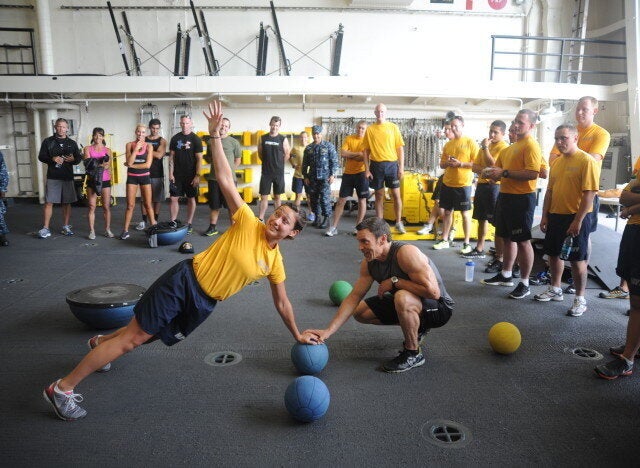
A few weeks ago I wrote an article on Why You're Getting Nowhere at the Gym, and How to Fix it. One of my key points was that most people don't challenge themselves enough with the amount of weight that they lift. People are seemingly happy to go through the motions of simply being at the gym without truly putting in the effort required to make any sort of progress. To many, ignorance is bliss-- so you can stop reading here if you're happy with your waning results. But here is why your workouts will be much more rewarding if you learn to push yourself at the gym.
What does intensity truly mean?
In most cases, intensity can be described as one's perceived effort, but for lifting weights in the gym, intensity refers to the amount of weight lifted. Increase the weight, increase the intensity. It's as simple as that. In regards to aerobic exercise where there are no weights involved to determine the intensity (I'll use running as an example), sprinting is far more intense than jogging. Doing as much as possible, as close to the maximum exertion you can put out, is intense.
Why does intensity matter?
Intensity matters because oxygen consumption correlates directly to calories burned. According to The Essentials of Sports and Exercise Nutrition by John Berardi, humans typically consume about 3.5 mL of oxygen per kg of body weight per minute, and our bodies burn about 4.8 calories per liter of oxygen consumed. This is how we calculate daily caloric requirements for sedentary individuals. When exercise is introduced into the mix, we consume more oxygen and therefore burn more calories. Are you more out of breath after walking, or after sprinting? After lifting a 5 lb weight or a 50 lb weight? This is why intensity is important. The harder you push yourself, the more oxygen you require, the more calories you burn.
The argument could end there, but oh, there's more. When you exercise intensely, not only do you burn excess calories during the activity, but you'll end up burning calories at a higher rate even after the workout is finished. We owe this to the concept of EPOC...
What is EPOC?
Excess post-exercise oxygen consumption (EPOC) refers to the increased rate of oxygen uptake by our bodies after performing an activity (again, see John Berardi). When we exercise, our bodies require more oxygen than when we are at rest. Even at a low intensity, exercise will create an oxygen deficit in our bodies, but it is indeed the level of intensity that determines the magnitude of this oxygen deficit. Since we cannot immediately provide the oxygen needed by our bodies during exercise, we continue to require extra energy post-workout. A low-intensity activity -- walking, jogging lightly, doing a few casual sets on the calf-raise machine at the gym -- will result in a short and unsubstantial EPOC, whereas a highly intense activity -- lifting heavy weights, multiple bouts of sprinting, etc.-- will result in longer and much more significant EPOC, which is when we can truly capitalize on our workouts.
How do we benefit from EPOC?
EPOC can remain elevated for minutes or hours, but it is directly proportional to the intensity of the activities performed. Some research shows that EPOC remains significantly higher within the 3 hours post-workout, but some suggest that intense exercise can lead to an increased metabolic rate for up to 38 hours. Essentially, your body will be scrambling post-workout to do several things: metabolize additional nutrients, replenish energy stores, reload oxygen stores in your muscles and blood, and decrease your elevated body temperature, heart rate and respiratory rate. Translated more simply: Your body will still be working very hard after an intense workout and will continue to burn calories at an elevated rate. If you don't push yourself, you'll burn fewer calories while at the gym, and fewer after the fact as well.
Take home points
-- Resistance training and high-intensity interval training produces a higher EPOC than steady-state exercise (walking, jogging, long-distance running, etc.)
-- Higher-intensity resistance training (think: heavier weights) disturbs the body's homeostasis to a greater degree and results in a larger energy requirement after exercise in order to restore the body's systems to normal
-- High-intensity exercise requires more energy both during the workout and post-workout (i.e., you burn more calories during your workout and in the hours following the workout)
- Higher-intensity training is superior for fat burning and weight loss, for the reasons explained above
- If you're working out and you're not sweating, not overheating, or not breathing hard, you should seriously consider increasing the weight and/or decreasing your rest time between sets
Although the benefits of high-intensity training are well documented, there are other important considerations. First of all, if you have any sort of pre-existing injury or health problem, make sure to consult a physician before engaging in any intense physical activity. Heavier weights require good form, and it takes time to master multi-articulated exercises like the squat, deadlift and upper body pushes. Prior to implementing high-intensity weightlifting programs, it is important to have mastered these exercises to prevent injury. It is also important to note that you will require more recovery post-workout with these types of programs as well; this entails better nutrition, increased rest, and attention to muscle and joint mobilization.
Push yourself, and you'll be amazed at the results!
